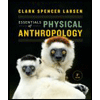Lab 1: An Introduction to Biological Anthropology
Prelab Concept Review Questions
1)
The two fundamental ideas in anthropology are the importance of context and the
use of a comparative approach.
2)
C – Biological Anthropology 3)
The biocultural approach in biological anthropology is an approach that recognizes human biology and culture are closely intertwined and as such need to be examined and understood simultaneously.
4)
B – Paleoanthropology 5)
A – Forensic Anthropology
6)
D – Interpretation 7)
In the context of the scientific method, the hypothesis is a testable explanation to an observation. The hypothesis can be supported or rejected by evidence obtained during data collection. It is different from a scientific theory by that a hypothesis can become a theory, but only after the same interpretation is supported by evidence from many different researchers and is widely accepted by the scientific community. 8)
Scientific theories are not absolute truths. Scientific theories are still open to reinterpretation and rejection in the face of new evidence; therefore, they cannot be considered absolute truths. 9)
A scientific theory is not a guess. It is an explanation that is supported by substantial evidence. 10)According to the American Association of Physical Anthropologists (AAPA) Code of Ethics, an anthropologist is primarily responsible to the people, species, and materials they study, as well as the people they partner with in their work.
Exercise 2
1)
I selected Scenario A.
2)
The primary subfield of biological anthropology addressed in this research is Paleoanthropology.
3)
This research relates to human evolution by discovering a new closer ancestor to
humans and chimpanzees than any other previously known species. It can also possibly give us a better understanding of human variation and adaptation based
on the environment contexts over time.

 Essentials of Physical Anthropology (Third Editio...AnthropologyISBN:9780393938661Author:Clark Spencer LarsenPublisher:W. W. Norton & Company
Essentials of Physical Anthropology (Third Editio...AnthropologyISBN:9780393938661Author:Clark Spencer LarsenPublisher:W. W. Norton & Company